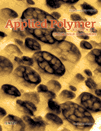Properties of HVA-2 vulcanized high density polyethylene/natural rubber/thermoplastic tapioca starch blends
Abstract
Blending of high density polyethylene (HDPE), natural rubber (NR), and thermoplastic tapioca starch (TPS) has been studied. Two series of blends having 5 wt %, 10 wt %, 20 wt %, and 30 wt % TPS were prepared: (a) unvulcanized blends and (b) N, N′-m-phenylenebismaleimide (HVA-2) vulcanized HDPE/NR/TPS blends. The composition of HDPE/NR was fixed at blend ratio of 70/30. Tensile strength, Young's modulus, and elongation at break exhibited significant improvement when HDPE/NR/TPS blends were subject to HVA-2 crosslinker. Tensile strength increased to 1.4 MPa, 2.3 MPa, 3.4 MPa, and 5.1 MPa from 15 MPa, 12 MPa, 9.7 MPa, and 7.87 MPa of unvulcanized counterparts. SEM micrographs showed fine TPS dispersion and well embedded in vulcanized HDPR/NR matrix. Comparison were also made based on the results of gel content, thermogravimetric analysis (TGA), and dynamic mechanical analysis (DMA). The improvement in tensile properties, thermal stability, and blends modulus can be correlated to the crosslink formation within the NR phase. © 2012 Wiley Periodicals, Inc. J. Appl. Polym. Sci., 2013




